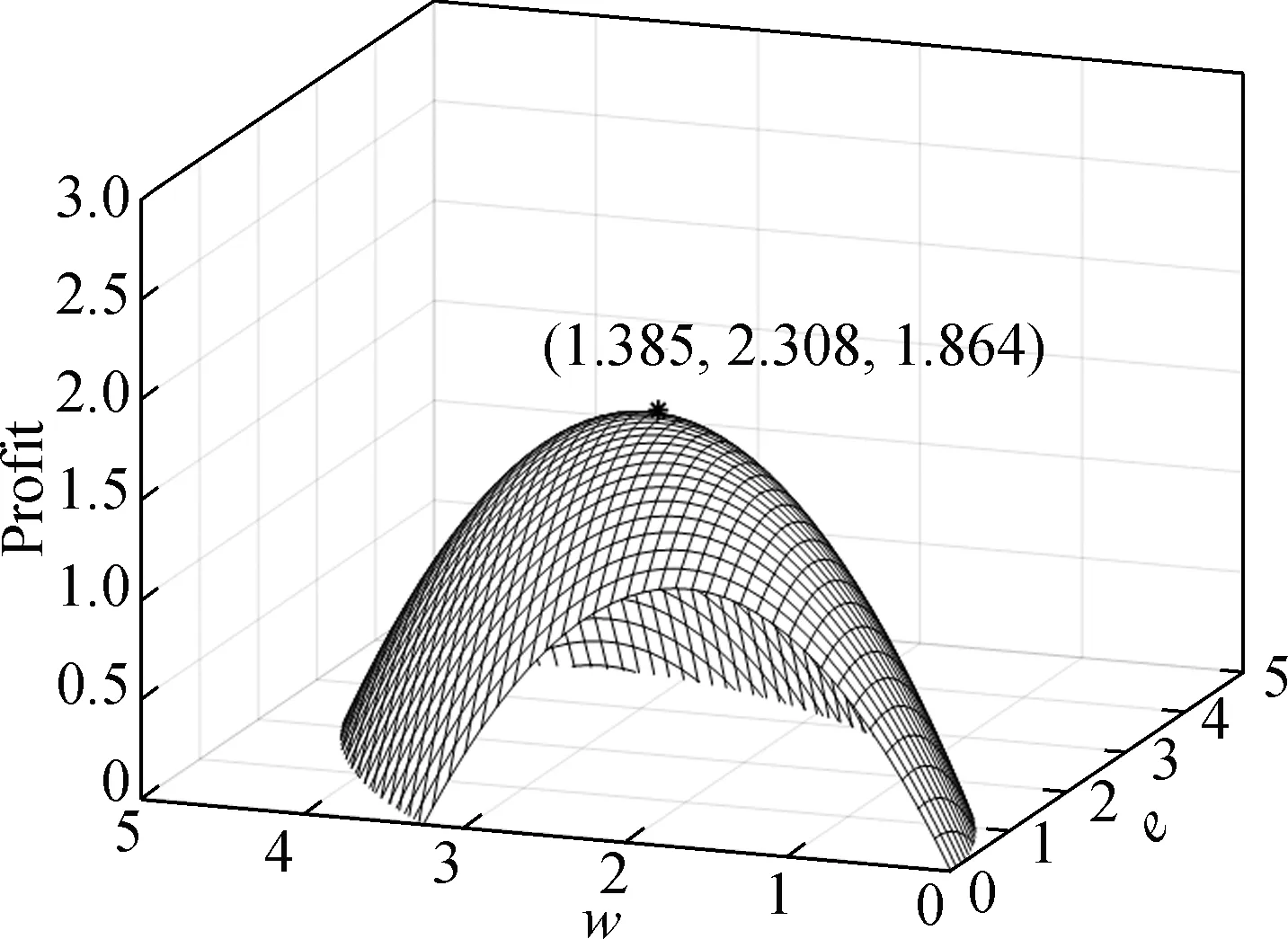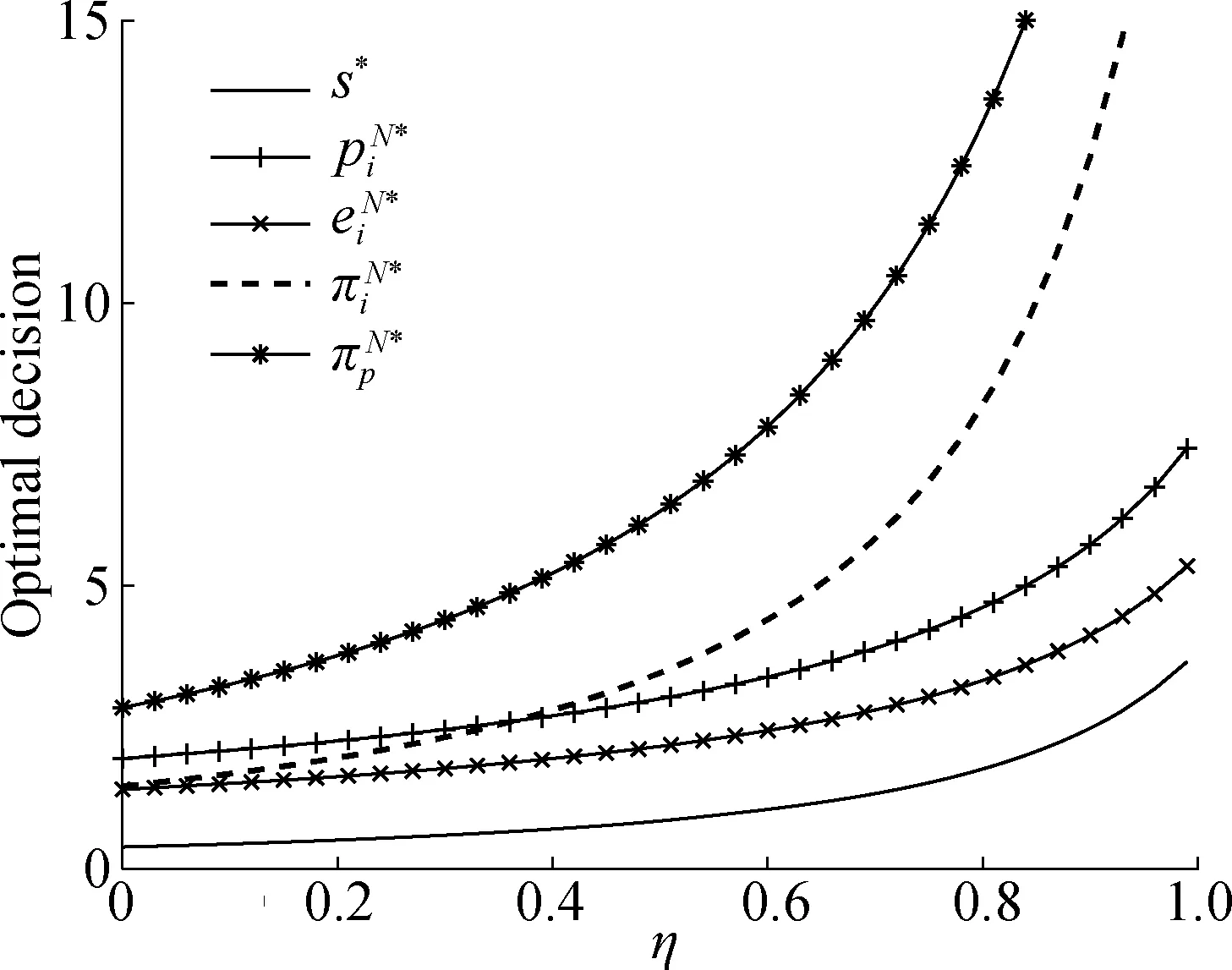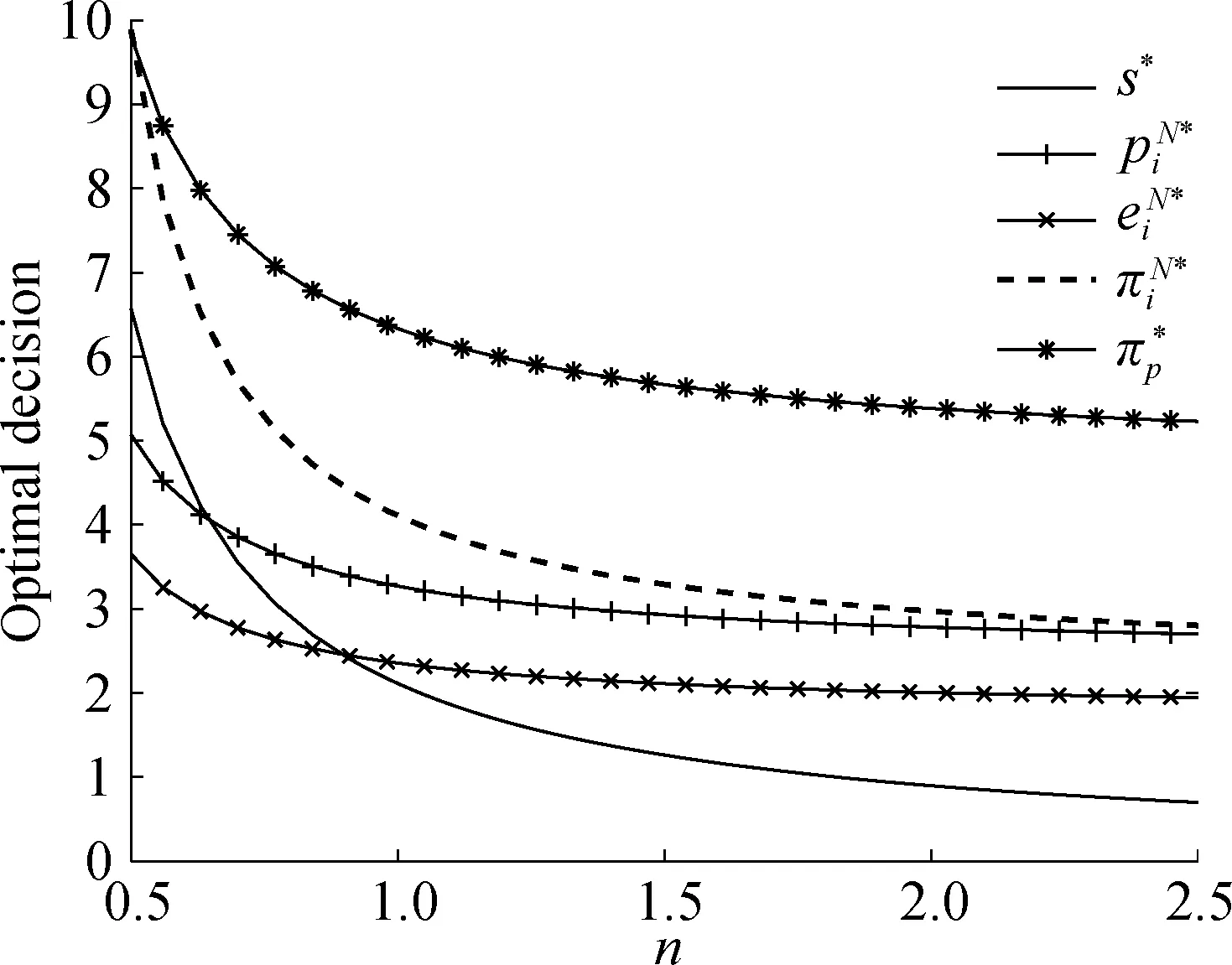Manufacturers’ channel selections under the influence of the platform with big data analytics
Qiu Huaqing Zhao Lindu
(School of Economics and Management, Southeast University, Nanjing 210096, China)
Abstract:To obtain the platform’s big data analytics support, manufacturers in the traditional retail channel must decide whether to use the direct online channel. A retail supply chain model and a direct online supply chain model are built, in which manufacturers design products alone in the retail channel, while the platform and manufacturer complete the product design in the direct online channel. These two models are analyzed using the game theoretical model and numerical simulation. The findings indicate that if the manufacturers’ design capabilities are not very high and the commission rate is not very low, the manufacturers will choose the direct online channel if the platform’s technical efforts are within an interval. When the platform’s technical efforts are exogenous, they positively influence the manufacturers’ decisions; however, in the endogenous case, the platform’s effect on the manufacturers is reflected in the interaction of the commission rate and cost efficiency. The manufacturers and the platform should make synthetic effort decisions based on the manufacturer’s development capabilities, the intensity of market competition, and the cost efficiency of the platform.
Key words:big data analytics; platform selling; channel decision-making; product design
Over the last decade, an increasing number of manufacturers have sold their products through e-commerce platforms. When compared to traditional retailers, e-commerce platforms are more convenient for gathering customer data. Indeed, customer data play essential roles in operational management[1], new product development[2], and channel distribution[3]. Therefore, the platforms begin sharing customer information with the sellers. For example, Tmall shared customer information with over 300 online sellers[4]. Moreover, JD started sharing information with Midea in 2015, Dell in 2016, and OPPO in 2018[5]. Manufacturers can design products that better meet the needs of their customers thanks to shared customer information.
From a platform-based perspective, several studies have examined the platform’s incentives to share demand information[6-7]and information-sharing strategies[8]. Manufacturers who sell their products through a traditional reselling channel must decide whether to adopt the platform channel to capitalize on customer information. Aside from pricing issues[9], forecast information from the platform may encourage manufacturers to build a direct channel through the platform[3-4]. Inspired by these studies, we explore the manufacturers’ channel selections in a competitive environment between the reselling channel and the direct online channel (via a platform). To convert large amounts of customer data into useful information, the platform in the direct online channel must invest in big data analytics technology. Manufacturers can improve product design efficiency by using customer information, which in turn improves customer satisfaction and market responsiveness[2].
Emerging studies have focused on mode selection in platform operations. For instance, a few studies explored the platform’s decision to act as a reseller or a marketplace[10-11]. Moreover, the extant literature has focused on the manufacturer’s decisions among different sales modes, such as direct selling, reselling, and marketplace modes[12-13], or the impact of online product reviews on platform selling[14]. In contrast to these studies, our model’s direct online channel not only provides a channel for manufacturers to reach customers but also benefits the manufacturers’ product design from the platform’s big data analytics.
Indeed, the connotation of product design includes a variety of details, such as product appearance, function, performance, and quality[15-16]. In this paper, we define a manufacturer’s design efforts as the ability to implement related design activities[15,17]. Manufacturers with high design efforts can precisely translate customer needs into product offerings and generate higher values; conversely, if a low design effort is chosen, customer needs will not be sufficiently satisfied and exert lower value. In our setting, the platform’s technical efforts and the manufacturers’ design efforts collaborate to promote product design in the direct online channel. The technical efforts of the platform refer to its investment in big data analytics to obtain customer information, while the design efforts of the manufacturers refer to the investments in design activities to utilize customer information.
To this end, we address the following research questions: 1) Under what conditions will manufacturers choose the direct online channel? 2) How do the platform’s technical efforts influence the equilibrium decisions? 3) What effects does competition have on equilibrium decisions? To answer these questions, we built a reselling supply chain comprised of two manufacturers and a retailer and a direct online supply chain comprised of two manufacturers and a platform. The direct online channel differs from the reselling channel in two ways. First, the platform gives manufacturers pricing power. Second, the platform invests in technical efforts to assist manufacturers in moving forward with product design. Then, using a game theoretic framework, we compare the reselling channel and the direct online channel.
1 Model Formulation
We study two competing manufacturers in the reselling channel (R) who are considering entering the platform-dominated direct online channel (N);jdenotes the channels,j={R,N}. By comparing their profits in different channels, the manufacturers decide whether to abandon the original reselling channel and enter the new direct channel. In both channels, each manufacturer offers a product in the same category, and the two products compete on a design level and product price. We call the manufacturer that offers productias manufactureri,i={a,b}.



(a)
We use a linear demand function, which is commonly adopted in operation management literature[21-22], to capture product competition in terms of design level and product price in the following way:
(1)
(2)

1.1 Problems in the reselling channel


(3)
(4)
1.2 Problems in the direct online channel

The following assumptions should be noted. First, in accordance with the assumption shared by the design-collaborating firms[24], the commission rateαis provided exogenously. This commission rate is usually the same for products in a common category; for example, JD.com charges a rate ranging from 5% to 12% of retail prices for most product categories[10]. Second, the platform bears the cost asns2/2 with technical effortss, wheren>0 is the cost coefficient. The profits of manufactureriand the platform (p) are derived as
(5)
(6)
2 Equilibrium and Analysis
We first solve the analytical model in this section. For the numerical simulations, we set the parameters asθ=3,n=2.5,α=0.4,k=1.2,s=0.8,γ=0.5 andη=0.4, which satisfy the thresholds in Proposition 1.
2.1 Equilibrium results
We solve the models by backward induction. In channelR, the equilibrium results are listed in Lemma 1.

In channelN,we obtain Lemma 2 when the platform’s efforts are exogenous given as follows.

In channelN, we obtain Lemma 3 when the platform’s efforts are endogenous given as follows.

2.2 Exogenous platform efforts
We begin by shedding light on a case in which the platform’s technical efforts are exogenous. This case not only corresponds to studies that explored the impact of power structure on channel interactions[25], but it enables us to illuminate the manufacturer’s direct online channel adoption conditions. Proposition 1 is derived by comparing players’ profits in channelNand channelR.
Proposition1The sufficient conditions for the manufacturers to choose a direct online channel are as follows:


The first condition indicates that manufacturers’ design capabilities to make channelNfeasible have an upper bound. This constraint is intended to prevent manufacturers from making unrestricted investments in design efforts. When the first condition is satisfied, the second condition states that the commission rate must be high enough to ensure the platform’s profitability. The final condition specifies the technical effort thresholds for the platform. Recall that the platform appropriatesαproportion of manufacturers’ revenues but should serve them by leveraging its technical advantages. The lower bound is due to the manufacturers’ need for the platform’s technical assistance, while the upper bound is due to the commission rate. That is, the platform will charge a higher commission rate if it can offer more technical advantages. The manufacturers prefer a suitable interval of the platform’s technical efforts to obtain the platform’s technical benefits while enjoying an acceptable fee.


(a)
In the following corollary, we examine the impact of the platform’s technical efforts on the manufacturers’ decisions.
Corollary 1 states that the platform’s greater technical efforts result in higher product prices, demands, design levels, manufacturers’ design efforts, and profits. Intuitively, as the platform’s technical efforts increase, the platform’s capabilities to assist manufacturers in achieving new product design increase, and the manufacturers have greater incentives to improve their design efforts. The advancement of the platform’s technical efforts and the manufacturers’ design efforts results in higher product design levels. Consequently, the manufacturers can mildly adjust product prices based on their high design levels to ensure adequate orders.
2.3 Endogenous platform efforts
This section analyzes the platform’s role further by treating the platform’s technical efforts as an endogenous variable. We investigate the difference in optimal solutions between channelsRandN. In addition to imposingk
Proposition2Comparing channelRand channelN, we have


Result 1 of Proposition 2 shows that, when compared with channelR, channelNalways gains a higher market demand. This is because the product design in channelNis better in line with the preferences of the customers. Results 2 and 3 show that when the platform’s cost efficiency is relatively low (i.e.,n>n1orn>n2) and the commission rate exceedsα′ or 1/2, channelNwill have lower product prices or lower design efforts than channelR, respectively. Recall that in channelN, manufacturers gain pricing power, so they will set appropriate product prices and design efforts that will benefit their profits. Will the platform’s and the manufacturer’s combined efforts always be superior to the manufacturer’s own efforts? Result 4 implies that design levels in channelNmay be lower than in channelR. This occurs when the platform’s cost efficiency and commission rate are both relatively low (i.e.,n>n3andα<1/2). Lower design levels are used in this case because the platform is less motivated to invest in technical efforts due to the lower commission rate. In summary, Proposition 2 shows that when the platform’s technical efforts are endogenous, its role in the direct online channel is reflected in the interaction of the platform’s commission rate and cost efficiency.
3 Impact Analysis
This section examines the effect of key parameters on optimal decisions. We focus on three critical points. We explore the effect of the manufacturers’ design capabilities on the equilibrium decisions of both channels. With a focus on channelN, we then study the influence of market competition and the platform’s cost efficiency.
Proposition3The manufacturers’ design capabilities show the following characteristics:


Results 1 and 2 of Proposition 3 provide an interpretation of the manufacturers’ design capabilities. The product prices, design efforts by manufacturers, demand, design levels, profits of the retailer and the platform all increase ink. However, the manufacturers’ profits in channelRincrease inkif and only ifk<(4+2η-8γ)/(1-γ), while in channelN, the manufacturers’ profits always increase ink. This is because the reselling channel limits the profitability of manufacturers with superior design capabilities. Fig.3 depicts numerical simulations of this proposition.

(a)
Proposition4Competition intensity shows the following characteristics:


Proposition 4 first demonstrates that strong price competition induces manufacturers to improve product prices and design efforts and the platform to improve technical efforts. Then, increasing design and technical efforts lead to an improvement in design levels, while increasing product prices lead to an increase in profits. This is due to the platform’s assistance in obtaining price advantages with high design levels. However, result 2 of Proposition 4 intuitively implies that when the players engage in an intense design competition, the manufacturers should choose lower product prices and lower design efforts, while the platform should choose lower technical efforts. Furthermore, as the design competitive intensityγincreases, the profits of the manufacturers and the platform decrease. Fig.4 vividly illustrates Proposition 4.

(a)

Proposition 5 posits that a lower cost efficiency of the platform (i.e.,a higher value of parametern) leads to lower platform technical efforts, product prices, manufacturer design efforts, design levels, and manufacturer and platform profits. These findings suggest that reduced cost efficiency crowds out the incentives for both manufacturers and platforms to invest in their efforts. The numerical simulation is shown in Fig.5 to help validate this proposition.

Fig.5 Impact of n
4 Conclusions
1) The establishment of the direct online channel is related to the manufacturers’ design capabilities, and platform’s commission rate and technical efforts. The upper bound of manufacturers’ design capabilities keeps their investment in a reasonable range, while a higher commission rate ensures the platform’s profit. Under these conditions, the manufacturers will choose the direct online channel if and only if the platform’s technical efforts are within a certain frame.
2) The platform’s exogenously given technical efforts have a positive effect on the manufacturers. However, in the endogenous case, this effect is reflected in the interaction of the platform’s commission rate and cost efficiency.
3) Price competition and manufacturer design capabilities have a positive impact on equilibrium decisions, while design competition and platform cost efficiency have an inverse impact.
4) Our findings have managerial implications for manufacturers’ channel decisions. However, some limitations exist, such as the fact that the demand function is linear and deterministic, and we do not account for platform competition.
 Journal of Southeast University(English Edition)2022年4期
Journal of Southeast University(English Edition)2022年4期
- Journal of Southeast University(English Edition)的其它文章
- General Contents of Vol.38, 2022
- Roughness evaluation of three-dimensional asphalt pavement based on two-dimensional power spectral density
- Robust SLAM localization method based on improved variational Bayesian filtering
- Deciding whether manufacturing firms share product links on owned social media considering fan effects
- Damage identification of steel truss bridges based on deep belief network
- WinoNet: Reconfigurable look-up table-based Winograd accelerator for arbitrary precision convolutional neural network inference
